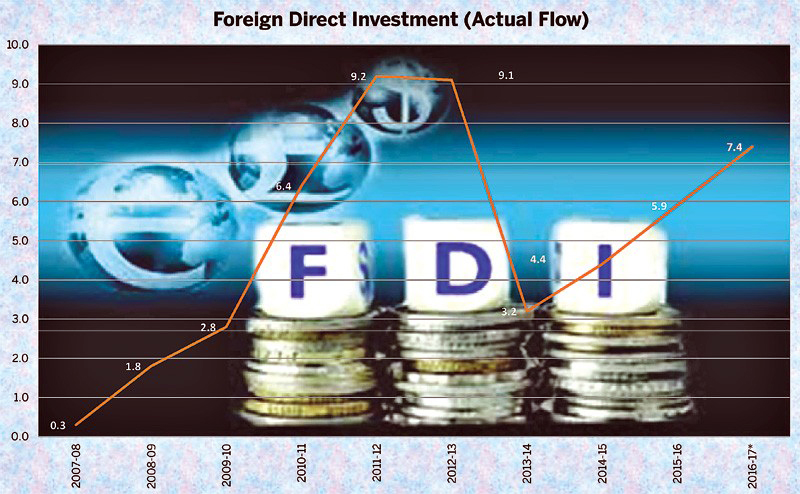To be attended by around 300 foreign delegates, including India’s finance minister and AIIB president
Kathmandu, March 2, 2017:Â The biggest investment summit being held in the country is kicking off on Thursday, drawing around 300 foreign delegates, mostly investors, who are expected to express commitment to invest in sectors ranging from infrastructure and mining to tourism and agriculture.
This is the second time the government is holding an investment summit, which will be attended by Indian Finance Minister Arun Jaitley and Jin Liqun, president of the Asian Infrastructure Investment Bank (AIIB), a new multilateral lending institution founded by China. The first one was held in early 1990s when Ram Krishna Tamrakar was the minister for industry, commerce and supplies.
“The initiative taken by the government to attract foreign investment is praiseworthy,†Ram Sharan Mahat, former finance minister and senior leader of the Nepali Congress, told the Post. “It is now time for everyone to leave behind petty interests and work hard to promote competition and fair play, ensure rule of law and frame policies that could actually lure foreign investors towards Nepal.â€
The summit is being held at a time when the country has launched second generation of reforms
Organised jointly by the Ministry of Industry and the Investment Board Nepal, the summit is being held at a time when the country has promulgated a new constitution and launched second generation of reforms to remove binding constraints to higher economic growth. Nepal has been grappling with a long spell of subpar economic growth, with annual growth standing at 2 to 5 percent on average in the last 50 years.
In 1965-1974, the country’s average economic growth stood at less than 2 percent per year. In between 1975 and 1984, it stood at around 3 percent.
The highest decadal growth was achieved in between 1985 and 1994, when economy expanded by around 5.2 percent per year on average. This was the result of the first round of economic liberalisation that took place towards the end of the Panchayat era in the late 1980s and in the first few years after restoration of multiparty democracy in the early 1990s. At that time, trade, banking and other sectors were opened up, and regulatory framework governing the private sector was made quite liberal.
These gains, unfortunately, were eroded once the Maoist insurgency began in 1996. Violent activities, on the one hand, dampened investor sentiment, while on the other prevented the government from expediting policy reforms.
Even after the end of the Maoist conflict in 2006 the situation did not improve much, and average economic growth in the last one decade has hovered around 4 percent per year.
But with the introduction of an inclusive and broadly-owned constitution in 2015-albeit some of the demands of Madhesis are yet to be addressed-a new wave of optimism is sweeping through the country. “The government has already started framing new laws or amending the old ones to synchronise with the new constitution,†said Ratish Basnyat, coordinator of the Investment Summit 2017. “We want to disseminate this message to foreign investors.â€
Nepal has recently introduced fairly liberal Acts on Industrial Enterprises, Special Economic Zones, and Banks and Financial Institutions. It has also introduced new Intellectual Property Policy and Mining Policy, while new Foreign Investment and Technology Transfer Bill, and Labour Bill are at final stages of being endorsed by Parliament.
“This spurt in policy changes has set the stage to attract foreign investors, who can play a key role in stimulating economic growth,†Basnyat said.
A World Bank study says Nepal needs to invest up to $18 billion in energy, transport, telecommunications, and water and sanitation infrastructure by 2020 to remove binding constraints to economic growth. More investment will be required to help Nepal transform into a middle-income economy by 2030.
“We know the government will not be able to mobilise all these financial resources on its own. That’s why we need foreign investment,†said Basnyat.
Some of the project proposals that the government will present at the Investment Summit are: chemical fertiliser plant, east-west railway link to India, Kathmandu-Kulekhani-Hetauda tunnel highway, second international airport at Nijgadh, East-West electric railway, Kathmandu Valley metro project, Kathmandu-Pokhara railway project, and Tamakoshi-3 hydropower project.
The government also intends to draw foreign investment in around 20 mines across the country that have deposits of limestone, copper, zinc and iron ore. Also, proposal to build special economic zones at Simara, Panchkhal, Biratnagar, Kapilvastu, Jumla and Dhangadi-whose feasibility studies have already been conducted-under public private partnership will be floated at the summit.
“We are hoping for very positive response from foreign investors, as we have initiated policy reform process, and started adding more power to the grid to eliminate power outages. Also, incidence of labour problems that previously soured investor relations has come down and investor-friendly labour law is soon being introduced,†Industry Secretary Shankar Prasad Koirala said.
By Rupak D Sharma







